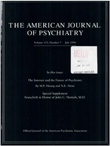Low lumbar bone mineral density in patients with major depression
Abstract
Major depression is associated with hypercorticoidism, a risk factor for osteoporosis. However, it is unknown whether depressive disorders are associated with alterations in bone mineral density. The authors measured the density of trabecular bone from the first to the third lumbar vertebra by quantitative computerized tomography in 80 depressed inpatients older than 40 years and in 57 healthy comparison subjects. An analysis of covariance model with age as a covariate showed a significant effect of diagnosis on the dependent variable spinal bone mineral density: depressed patients had lower values. Other factors could not explain the finding. The authors conclude that major depression is a significant risk factor for osteoporosis.
Access content
To read the fulltext, please use one of the options below to sign in or purchase access.- Personal login
- Institutional Login
- Sign in via OpenAthens
- Register for access
-
Please login/register if you wish to pair your device and check access availability.
Not a subscriber?
PsychiatryOnline subscription options offer access to the DSM-5 library, books, journals, CME, and patient resources. This all-in-one virtual library provides psychiatrists and mental health professionals with key resources for diagnosis, treatment, research, and professional development.
Need more help? PsychiatryOnline Customer Service may be reached by emailing [email protected] or by calling 800-368-5777 (in the U.S.) or 703-907-7322 (outside the U.S.).



